Description
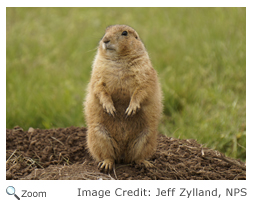 The black-tailed prairie dog is a member of the squirrel family and is closely related to the ground squirrel. It has yellowish to reddish-brown fur on its back and sides and lighter colored fur under its neck and on its chest. It has small ears on the sides of its head; a long body; small front paws with long claws; and a short, black-tipped tail. The black-tailed prairie dog is a member of the squirrel family and is closely related to the ground squirrel. It has yellowish to reddish-brown fur on its back and sides and lighter colored fur under its neck and on its chest. It has small ears on the sides of its head; a long body; small front paws with long claws; and a short, black-tipped tail.
Range 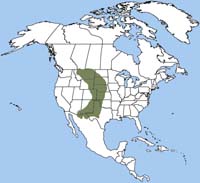 The black-tailed prairie dog's historic range stretched from extreme southern Saskatchewan in Canada and Montana south through the western and central Great Plains to the desert grasslands of western Texas, New Mexico, southeastern Arizona and northeastern Sonora, and northern Chihuahua in Mexico. Loss of prairie habitat has led to its disappearing from parts of its historic range. It is still found in Arizona, Colorado, Kansas, Montana, Nebraska, New Mexico, North Dakota, Oklahoma, South Dakota, Texas, and Wyoming. The black-tailed prairie dog's historic range stretched from extreme southern Saskatchewan in Canada and Montana south through the western and central Great Plains to the desert grasslands of western Texas, New Mexico, southeastern Arizona and northeastern Sonora, and northern Chihuahua in Mexico. Loss of prairie habitat has led to its disappearing from parts of its historic range. It is still found in Arizona, Colorado, Kansas, Montana, Nebraska, New Mexico, North Dakota, Oklahoma, South Dakota, Texas, and Wyoming.
Habitat 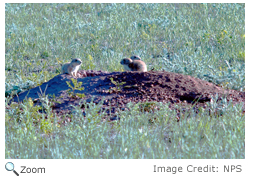 The black-tailed prairie dog lives in burrows in dry prairies with short grass. Their burrows have an entrance that is surrounded by a pile of dirt. The entrance to a prairie dog burrow looks a little like a volcano. The mound of dirt protects the burrow from flooding and is a good place for the prairie dog to sit and watch for predators like badgers, coyotes, foxes, bobcats, eagles, and hawks. The burrow entrance leads to a tunnel that goes down about three to ten feet and then straightens out to a horizontal tunnel that runs about 10 to 15 feet. The burrow has a number of nesting chambers lined with grass. It also has a separate chamber used as a bathroom. When that chamber is full, the prairie dog will dig a new one. The black-tailed prairie dog lives in burrows in dry prairies with short grass. Their burrows have an entrance that is surrounded by a pile of dirt. The entrance to a prairie dog burrow looks a little like a volcano. The mound of dirt protects the burrow from flooding and is a good place for the prairie dog to sit and watch for predators like badgers, coyotes, foxes, bobcats, eagles, and hawks. The burrow entrance leads to a tunnel that goes down about three to ten feet and then straightens out to a horizontal tunnel that runs about 10 to 15 feet. The burrow has a number of nesting chambers lined with grass. It also has a separate chamber used as a bathroom. When that chamber is full, the prairie dog will dig a new one.
Diet
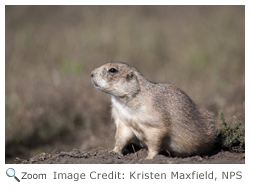 The seeds stems, roots and leaves of forbs (flowering plants), grasses, and weeds make up most of the prairie dog's diet. It sometimes eat grasshoppers, beetles, and other insects. The seeds stems, roots and leaves of forbs (flowering plants), grasses, and weeds make up most of the prairie dog's diet. It sometimes eat grasshoppers, beetles, and other insects.
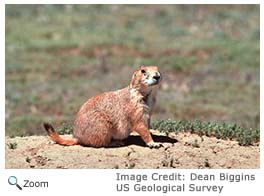 The prairie dog gets most of the water it needs from the plants it eats. It usually eats all the plants right around its burrow. Clearing away the plants around the burrow helps the prairie dog spot predators. In the fall, the prairie dog puts on a layer of fat to help it survive in the winter. The prairie dog doesn't hibernate, but when the winter weather is extremely cold or snowy, it may go into a light hibernation-like sleep and stay in its burrows for a few days. The prairie dog gets most of the water it needs from the plants it eats. It usually eats all the plants right around its burrow. Clearing away the plants around the burrow helps the prairie dog spot predators. In the fall, the prairie dog puts on a layer of fat to help it survive in the winter. The prairie dog doesn't hibernate, but when the winter weather is extremely cold or snowy, it may go into a light hibernation-like sleep and stay in its burrows for a few days. | |
Life Cycle 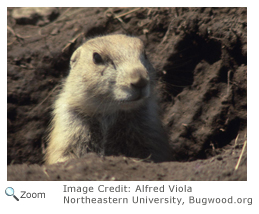 Mating season runs from February through March. A month after mating, the female has three to four pups. The pups are born naked and with their eyes closed. They stay in the burrow for about six weeks. They are weaned when they are about seven weeks old but stay near their mother for another two weeks. Mating season runs from February through March. A month after mating, the female has three to four pups. The pups are born naked and with their eyes closed. They stay in the burrow for about six weeks. They are weaned when they are about seven weeks old but stay near their mother for another two weeks.
Female prairie dogs are very aggressive when they have pups. They often fight with other females to guard their territory and their pups. Female prairie dogs may even invade the burrows of other female prairie dogs and kill any pups they find. The black-tailed prairie dog has one litter a year.
Behavior 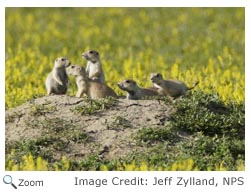 Prairie dogs are very social animals. They are active in the day and live in large colonies or towns. A prairie dog town can have thousands of prairie dogs in it. Prairie dogs are very social animals. They are active in the day and live in large colonies or towns. A prairie dog town can have thousands of prairie dogs in it.
A prairie dog town is separated into smaller neighborhoods and the neighborhoods are divided into smaller family groups. A family group or coterie is made up of a male and one to four females and their young. Prairie dogs greet each other by touching noses or turning their heads sideways and touching incisors. They also groom each other and work together to build their burrows. Prairie dogs are territorial and protect their coterie from other prairie dogs.
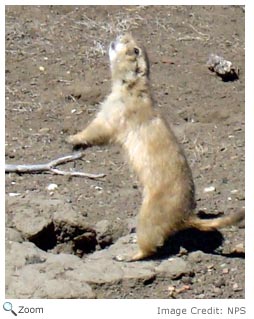 Prairie dogs are very vocal animals and have lots of different calls. They use yips, growls, chattering, barks, and chirps to signal different things. When there is danger, prairie dogs have a call that is a chirp and a wheeze. Once one prairie dog starts the warning, others continue the call. When it is safe, the prairie dog will leap in the air and yip. Other prairie dogs hear the all-clear call, and soon the whole town is yipping and jumping. Prairie dogs are very vocal animals and have lots of different calls. They use yips, growls, chattering, barks, and chirps to signal different things. When there is danger, prairie dogs have a call that is a chirp and a wheeze. Once one prairie dog starts the warning, others continue the call. When it is safe, the prairie dog will leap in the air and yip. Other prairie dogs hear the all-clear call, and soon the whole town is yipping and jumping.
Video Credit: US Fish and Wildlife
|



 The black-tailed prairie dog's historic range stretched from extreme southern Saskatchewan in Canada and Montana south through the western and central Great Plains to the desert grasslands of western Texas, New Mexico, southeastern Arizona and northeastern Sonora, and northern Chihuahua in Mexico. Loss of prairie habitat has led to its disappearing from parts of its historic range. It is still found in Arizona, Colorado, Kansas, Montana, Nebraska, New Mexico, North Dakota, Oklahoma, South Dakota, Texas, and Wyoming.
The black-tailed prairie dog's historic range stretched from extreme southern Saskatchewan in Canada and Montana south through the western and central Great Plains to the desert grasslands of western Texas, New Mexico, southeastern Arizona and northeastern Sonora, and northern Chihuahua in Mexico. Loss of prairie habitat has led to its disappearing from parts of its historic range. It is still found in Arizona, Colorado, Kansas, Montana, Nebraska, New Mexico, North Dakota, Oklahoma, South Dakota, Texas, and Wyoming.




